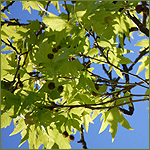Apologies that this post refers to information issued in a press release by the US Forest Service back in January, but it contains interesting data and links that could be of use to people – Take Cover team.
US Forest Service Southern Research Station (SRS) ecologist Jim Miller, considered to be one of the foremost authorities on non-native plants in the southern US, has identified the five invasive plant species he believes pose the biggest threats to southern forest ecosystems in 2009.
 “Cogongrass, tallowtree, and Japanese climbing fern are among the fastest moving and most destructive non-native plant species facing many southern landowners this year,” Dr Miller warned.
“Cogongrass, tallowtree, and Japanese climbing fern are among the fastest moving and most destructive non-native plant species facing many southern landowners this year,” Dr Miller warned.
“Rounding out the top five invasive species that I’m very concerned about would be tree-of-heaven and non-native privets.
“While our forests are besieged by numerous invasive plants, these and other non-native species present serious financial and ecological threats to the South and its forests.”
Non-native species often out-compete native forest plants and may degrade forest productivity, wildlife habitat, recreational values, and water quality.
Invasive species also greatly increase expenses as public and private land managers work to combat their spread and deal with their effects (such as increased wildfire risk and severity).
Non-native plants can be introduced and spread by wildlife or through other natural means.
Humans also spread invasive species by planting them in their gardens and yards and as a result of seeds hitchhiking on clothes.
Additionally, tractors and mowers used in multiple locations without being cleaned often spread the plants.
In an effort to inform forest managers, landowners, and others about where the most threatening invasive plants are in the South, Dr Miller collaborated with SRS Forest Inventory and Analysis (FIA) scientists to develop maps showing the spread, county-by-county, across the south-east of more than 30 of the most serious non-native plant species.
The invasive plant data were collected on FIA plots throughout the southern US in co-operation with state forestry agencies.
In partnership with the University of Georgia’s Center for Invasive Species Science and Ecosystem Health, SRS researchers recently posted the maps and occupation levels online.
Dr Miller hopes government agencies, forest managers, natural resource professionals, landowners, students, and others will use the information to help combat the spread of non-native plant species in southern forest and grassland ecosystems.
Source: US Forest Service press release
Date: 12/01/2009
Filed under: conservation, invasive speices, research | Tagged: biodiveristy loss, biology, botany, climbing fern, cogongrass, ecological costs, economic costs, forest management, forests, habitat loss, invasive species, jim miller, non-native, privet, research, science, seed transmission, tallow, tree of heaven, trees, university of georgia, US, us ofrest service, wildfire, woodlands | Leave a comment »





